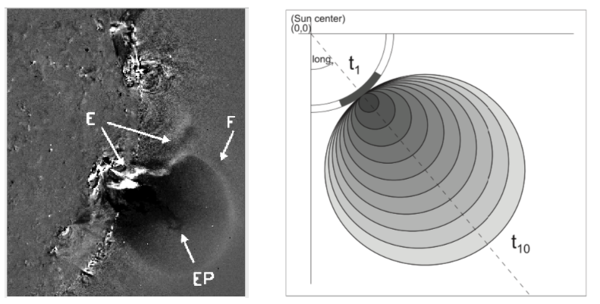Bridging solar flares to coronal mass ejections
From RHESSI Wiki
| Nugget | |
|---|---|
| Number: | 422 |
| 1st Author: | Markus Aschwanden |
| 2nd Author: | |
| Published: | 13 December 2021 |
| Next Nugget: | The longest flare |
| Previous Nugget: | The Jakimiec Diagnostic Diagram |
| List all | |
Contents |
Introduction
While solar flares often are accompanied by coronal mass ejections (CMEs), the identification of associated events is far from trivial. Flares and CMEs may occur in near-synchronized times, but there are a lot of exceptions, such as flares without CMEs (in the case of non-eruptive or confined events), or CMEs without flares (so-called "stealth CMEs," Ref. [1]). Ambiguities in the association of flares with CMEs occur frequently also, especially when multiple flares occur during a single CME. The opposite case occurs less frequently. Another difficulty is insufficient time resolution in the cadence of coronagraphs, amounting to as much as 12 minutes for a major data source, the LASCO/SOHO coronagaph. The really interesting high-speed CMEs may only produce a single snapshot in the low corona at this rate.
The Neupert effect
The Neupert effect was discovered in an early comparison of flare soft X-ray and microwave emissions (Ref. [2]). A related close correlation exists (Ref. [3]) between the hard X-ray (20 keV) flux from HXRBS/SMM and the peak of the time derivative of the soft X-ray (1 - 8 Å) flux from GOES/XRS, for example.
The physics of the Neupert effect has been modeled in terms of the thick-target collisional bremsstrahlung process, which acts as the main source of heating and mass supply (via "chromospheric evaporation") of the SXR-emitting hot coronal plasma. We note that other physical models might serve as well, on the grounds that any sudden energy release will drive hot gas into the corona, where it can cool relatively slowly.
Bridging the gap
Usually, hard X-ray emission from solar flares, the most reliable indicator of a flare event, is detected within less than 0.1 solar radius, while coronagraphs detect white-light continuum from CMEs only out at distances of 3-30 solar radii. There is a crucial gap in tracking CMEs between 0.1 and 3 solar radii (for LASCO/SOHO data), which is just the most interesting part of a CME path where acceleration of CMEs occurs. This gap is partially filled by EUV observations, but these have temperature sensitivity and thus do not directly reflect the mass distribution without some ambiguity. Here we explore how this gap between the lower corona and the heliospheric path can be bridged, using the Neupert effect to define the starting time of CMEs, from which the CME path can be interpolated across the coronal/heliospheric gap. Figure 2 shows how this works.

Using the Neupert effect we can directly measure the acceleration rates and durations as a function of the propagation distance. Interestingly, the so-measured propagation distances are consistent with the hydrostatic scale height of the solar corona (Ref. [5]). Figure 2 shows two examples from major X-class solar flares
Conclusions
Ref. [5] finds that 65\% of the analyzed 576 flare/CME events are consistent with the Neupert timing. The median duration of CME acceleration is 3 min, and the median acceleration distance is 40 Mm, which corresponds to the hydrostatic scale height of the solar corona with a temperature of T=0.8 MK. The results are consistent with standard flare/CME models that predict magnetic reconnection and synchronized (primary) acceleration of CMEs in the low corona (at a height of <0.1 RSun), while secondary (weaker) acceleration and then deceleration may occur further out at heliospheric distances.
References
[1] "Stealth Coronal Mass Ejections: A Perspective"
[2] "Comparison of Solar X-Ray Line Emission with Microwave Emission during Flares"
[3] "The Neupert effect - What can it tell us about the impulsive and gradual phases of solar flares?"
[4] "{EIT and LASCO Observations of the Initiation of a Coronal Mass Ejection"
[5] "Global Energetics in Solar Flares. XIII. The Neupert Effect and Acceleration of CMEs"
| RHESSI Nugget Date | 13 December 2021 + |
| RHESSI Nugget First Author | Markus Aschwanden + |
| RHESSI Nugget Index | 422 + |
